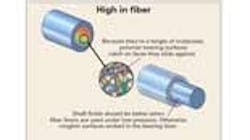Q&A
Q: What causes stiction?
A: A fluctuating coefficient of friction between the bearing liner and shaft causes stiction. Because they’re a tangle of long molecules, polymer bearing surfaces deform slightly and catch on faces they slide against. During slow speeds or under light loads, the interface wavers between static and dynamic coefficients of friction. The peaks and valleys on a shaft surface can compound the problem, hooking into the polymer only to suddenly let go once a critical torque is reached.
Q: How can surface finish reduce jerky motion caused by stiction?
A: Because rougher shaft surfaces increase the coefficient of friction at the journal bearing interface, its finish should between 16 and 32 Ra — closer to 16 Ra when the system is especially prone to stick-slip. This is particularly important when fiber liners are used with pressures under 6,000 psi. Otherwise, the higher peaks on rougher surfaces embed in the bearing liner and increase initial breakaway friction.
It’s similar to the initial greasing of a roller bearing, which simply prolongs the break-in process until lubricant is used up or pushed out. Above 6,000 psi, the shaft’s ridges are sheared and the fiber’s valleys are filled with PTFE significantly faster due to the increased shear stress — so stick-slip ceases to be a problem.
Q: Are different polymer journal bearing designs better at fighting stiction?
A: The rule is: Use a specially layered tape liner on your bearing if pressures can be kept to 3,000 psi or below. Otherwise, bearing length should be shortened to keep pressures above 6,000 psi, and a homogeneous fiber liner should be used. That’s because tape liners can’t carry pressures above 3,000 psi, but fiber liners are prone to stiction when pressures dip below 6,000 psi. (In comparison, fiber-lined bearings can operate as high as 20,000 psi.)
How does tape fight stiction? Its relative softness makes it less sensitive to surface finish. Instead of gently shearing down peaks, tape fills in the valleys on shaft surfaces; even under startup conditions, tape liner coefficient of friction is very low — about 0.1 if honed correctly. On the other hand, the non-isolated epoxy resin present at a fiber liner’s surface increases the coefficient of friction to about 0.2.
Tips provided by Herb Burnell, Senior Application Engineer of Polygon Co. in South Bend, Ind. For more information, call (800) 918-9261.
About the Author
Elisabeth Eitel
Elisabeth Eitel was a Senior Editor at Machine Design magazine until 2014. She has a B.S. in Mechanical Engineering from Fenn College at Cleveland State University.
